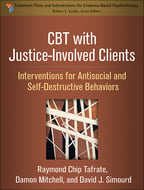Risk Assessment is Not the Same as Case Formulation

We would like to start with a story. Picture a courthouse in a struggling industrial town in Connecticut. The adult probation department is situated in the basement of this courthouse. We are beginning training with a new cohort of probation officers, teaching them how to incorporate forensic CBT techniques into their work. To start, one of the officers describes a current case and reviews the available assessment information. A quick review of the risk assessment reveals this is a high-risk case; a major area of concern is antisocial companions. We ask the officer to explain how friends and companions specifically influence criminal behavior for this justice-involved client (JIC). We get crickets! We ask, what role did friends play in the most recent offense? Again, an awkward silence permeates the room. While the officer certainly knows that antisocial companions is a risk factor for reoffending, she has not explored the nature of the JIC’s relationships and discussed with the JIC the specific role of companions in his offense history and daily routines. Unfortunately, this is a common training scenario when we begin.
What’s happening here? Why isn’t the assessment process being utilized as a mechanism for exploring and understanding the fabric of JICs’ lives? Why isn’t it guiding intervention plans and discussions during the JIC’s office visits? We think the problem occurs when risk assessments are conducted without accompanying case formulation (or case planning). Risk assessment and case formulation are distinct processes, and both are necessary for effective supervision.
Risk Assessment is an analysis of the characteristics and behavior patterns of JICs and the prediction of re-offending using probability estimates derived from validated risk instruments.
Risk assessment information offers the potential to improve judgments about a JIC’s risk to public safety. Risk assessment also increase correctional efficiencies by placing JICs into proper interventions and supervision levels. The risk principle is a component of contemporary correctional practice based on pairing correctional resources to the magnitude of a JIC’s risk for re-offending. More time and energy go into higher risk JICs and fewer resources are directed toward lower risk JICs. The use of properly validated risk/need assessment instruments is key to that process. There are a plethora of risk/need assessment tools available; most of which include established risk factors, such as the Central Eight (described in an earlier blog). When done properly, there are additional benefits of risk assessment such as reduced bias in professional decision-making and providing a source of base-line data for agencies and programs.
Case Formulation is the process of integrating assessment information and forming opinions about the causes and maintenance of antisocial behavior and identifying intervention targets most likely to reduce future criminal behavior for an individual JIC.
Case formulation provides a rich perspective about a JICS’s functioning which allows for a proper supervision plan. In that sense, case formulations guides supervision activities and inform community referrals. Validated risk instruments (with their predictive algorithmic methodologies) are critical in sorting populations, understanding the key variables to focus on, and provide an important stream of information regarding a specific JIC. However, such a top-down down approach will never be enough to understand how criminal behavior, for a particular case, is maintained. A bottom up approach, that includes a comprehensive analysis of the individual JIC adds value beyond risk assessment protocols because supervision and interventions can be tailored to a particular person, problem, and situational context. As noted in a previous blog, how a given risk domain translates into antisocial behavior can differ substantially from JIC to JIC. Case formulation also results in understanding how a JIC’s functioning in one risk domain area is impacting his or her behavior in others.
The point we are trying to make is that conducting risk assessment does not mean doing case formulation or quality supervision and intervention. Likewise, doing competent supervision or intervention doesn’t automatically translate into good risk assessment. One does not guarantee the other. We need to do a better job integrating both approaches into our work with JIC's.
A Training Conundrum
This issue is deeply embedded in how we train community corrections officers and case managers. Jurisdictions are being pressured into incorporating risk assessment into their work flow and such initiatives have been “Rolled Out” across the country – a term that sends chills down our spines. “Rolling it Out” often means that officers and case managers will be trained to do a task that involves, at best, checking boxes and recording that information into the case file, with little appreciation of how to utilize the assessment to guide supervision and intervention practices.
Risk assessment is often trained in a void, with little time devoted to case formulation concerns such as discussing the complexity of how individual risk domains play out in the real-world-lives of JICs. For example, a case formulation that provides a practical understanding how a specific JIC’s companions might influence his or her criminal behavior might involve answering the following questions:
- What’s the overall proportion of prosocial vs. antisocial friendships for the JIC?
- What proportion of the JIC’s criminal behavior occurs in the presence of friends (10%, 50%, 80%)?
- Is there one companion in particular that seems to be linked to criminal events for the JIC?
- What is the JIC’s recent degree of exposure (i.e., proportion of time spent with prosocial & antisocial influences) related to various friends and companions?
- How does the JIC’s social media connect with criminality?
- How are friends specifically influencing the JIC’s criminal behavior (e.g., is the JIC a leader or follower)?
- Who among his companions does the JIC most admire and want to emulate?
- Does the JIC have prosocial relationships that are dormant and that might be reactivated?
- What is the link between friends and the JIC’s maladaptive leisure time?
- How do friends reinforce the JIC’s risky behavior in other risk domains such as substance abuse/misuse, lack of connection to work/school, criminogenic thinking, etc.?
- What is the role of self-selection in the JIC’s antisocial companions (e.g., seeks out friends who share similar attitudes regarding sex with minors, extremist views, recreational substance use, etc.)?
- What opportunities exist for improving social networks?
- What deficits and impairments will interfere with developing new friendships?
Training probation officers and case managers in how to use risk assessment tools, before they understand case formulation around risk domains, is a cart-before-the-horse situation. The corrections field trains risk assessment and assumes that case formulation skills will naturally follow; that rarely happens. Case formulation is a foundational skill that also enhances risk assessment. When a practitioner understands case formulation, their risk assessments are more thorough, more useful, and allow for tailored case plans. The supervision process becomes more strategic and skilled. It’s not enough to check the box to indicate that a risk factor is present! It's understanding what’s behind the checked box that is most important.
 What works and doesn’t work when using Cognitive-behavioral therapy (CBT)? This is something the authors, Raymond Chip Tafrate, PhD, Damon Mitchell, PhD, & David J. Simourd, PhD, of this blog series have spent a long time studying and have put all they’ve learned in the book: CBT with Justice-Involved Clients: Interventions for antisocial and self-destructive behaviors. We thought our subscribers would be interested in a blog series on this content, knowing so many use or refer their clients to this type of treatment. Therefore, we are pleased to announce a blog seriesblog on Adapting CBT for Justice-Involved Clients.
What works and doesn’t work when using Cognitive-behavioral therapy (CBT)? This is something the authors, Raymond Chip Tafrate, PhD, Damon Mitchell, PhD, & David J. Simourd, PhD, of this blog series have spent a long time studying and have put all they’ve learned in the book: CBT with Justice-Involved Clients: Interventions for antisocial and self-destructive behaviors. We thought our subscribers would be interested in a blog series on this content, knowing so many use or refer their clients to this type of treatment. Therefore, we are pleased to announce a blog seriesblog on Adapting CBT for Justice-Involved Clients.
The trajectory of the science and practice of cognitive-behavioral therapy (CBT) models began with a focus on internalizing mental health syndromes such as depression and anxiety and was later extended to externalizing problems such as substance misuse, anger dysregulation, and personality pathology. Although CBT has grown into a large collection of interventions applicable to diverse client groups, attention to justice-involved clients (JICs) is substantially more limited. This is noteworthy because CBT has been found to be effective in addressing the self-destructive patterns common among JICs. This suggests that interventions using CBT techniques can alter the criminal risk potential of JICs, which in turn may lead to less risky decision-making and behaviors, and ultimately a safer society.
The practical application of any intervention approach often requires adaptation when delivered to a unique client group; and this occurs with CBT and JICs. We have been fortunate to have been involved in vast activities with JICs over the years. This has included developing and implementing intervention programs, providing training, consultation, and direct service to JICs. We have also worked with front-line criminal justice personnel in both custody and community settings. CBT techniques have been a constant theme in all our work with JICs and criminal justice personnel. Along the way, we have refined what works, eliminated what didn’t work, and examined the impact the interventions had on recidivism. In this blog series we will discuss what we have learned about tailoring CBT when working with JICs within a community corrections context.
|
Raymond Chip Tafrate, PhD |
Damon Mitchell, PhD |
David J. Simourd, PhD |
* These blogs are meant to present brief tips and strategies for agencies, programs, and practitioners. Readers who want more science, history, or detailed descriptions of “how to” conduct forensic CBT interventions may consider the following resource: CBT with justice-involved clients: Interventions for antisocial and self-destructive behaviors.
** There are many terms commonly used to describe people receiving services in criminal justice settings: offender, juvenile delinquent, probationer, parolee, prisoner, inmate, court mandated client, and patient, to name just a few. We commonly use the term justice-involved client (JIC). The abbreviation JIC is not intended to communicate any notion of inherent badness; instead, it’s meant to convey the complexities and challenges associated with the larger context in which intervention is delivered, while sidestepping the pitfalls of pejorative labels.




